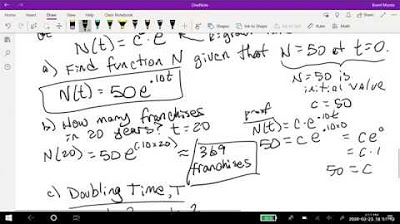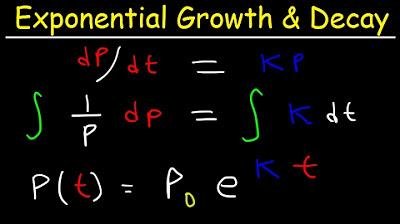Basic Population Models in Differential Equations (Differential Equations 32)
TLDRThis video delves into the mathematical modeling of population dynamics, focusing on the logistic equation and its applications. The presenter explores theoretical concepts such as extinction, doomsday, bounded and unbounded growth, and sets up word problems to illustrate these ideas. Two examples are discussed in detail: a squirrel population model where the growth rate is proportional to the square root of the population, and a rabbit population model with a growth rate proportional to the square of the population. The video emphasizes the importance of understanding the implications of these models, such as predicting population explosions and the potential for doomsday scenarios where populations grow without bound.
Takeaways
- 📈 The logistic equation is explored in the context of population dynamics, focusing on concepts like extinction, doomsday, bounded growth, and unbounded growth.
- 🔢 The video introduces two examples to demonstrate how to set up and think about population growth problems, particularly focusing on rates of change and initial conditions.
- 🦔 The first example discusses a squirrel population model where the rate of change is proportional to the square root of the population, with an initial population of 100 squirrels and an increase of 20 squirrels per month.
- 🧭 By solving the differential equation, the video shows that the squirrel population grows without bound, as there is no limiting factor in the model.
- 🐰 The second example involves a rabbit population model with a growth rate proportional to the square of the population, starting with 12 rabbits, and increasing to 24 after 10 years.
- 🔍 The video emphasizes the importance of carefully reading and extracting information from word problems to set up the appropriate differential equations.
- 📝 The process of solving the differential equations involves integration and solving for the arbitrary constant using initial values provided in the problem.
- 🌱 The rabbit population example reveals a slow initial growth that eventually leads to an explosive increase in population, approaching a doomsday scenario where the population size reaches infinity.
- ⏰ The video highlights the need to consider not only the immediate answers to the problems but also the long-term implications and trends in population growth.
- 🎯 The examples serve to prepare viewers for more complex problems involving the logistic equation in future videos.
- 🤔 The video encourages critical thinking about population dynamics and the potential real-world consequences of different growth patterns.
Q & A
What is the logistic equation discussed in the video?
-The logistic equation is a mathematical model used to describe population growth or decay. It is particularly useful in modeling scenarios where the growth rate of a population is affected by the carrying capacity of the environment, leading to an S-shaped growth curve.
What are the two main types of growth discussed in the video?
-The two main types of growth discussed in the video are bounded growth and unbounded growth. Bounded growth refers to a situation where the population growth is limited by certain factors, such as available resources, leading to a stable population size. Unbounded growth, on the other hand, refers to a situation where the population grows without limit, potentially leading to a population explosion.
How is the rate of change of a population related to the population itself in the squirrel example?
-In the squirrel example, the rate of change of the population is directly proportional to the square root of the population itself. This means that the growth rate of the squirrel population is tied to its current size, with larger populations leading to slower growth rates due to the square root relationship.
What is the initial condition given for the squirrel population in the example?
-The initial condition given for the squirrel population in the example is that at time zero (T=0), there are 100 squirrels present.
What is the rate of increase for the squirrel population at the start?
-At the start, the squirrel population is increasing at a rate of 20 squirrels per month.
How does the video demonstrate solving for the constant of variation in the squirrel population example?
-The video demonstrates solving for the constant of variation by using the initial condition of 100 squirrels at T=0 and the given rate of increase of 20 squirrels per month. By substituting these values into the derived differential equation, the constant of variation (K) can be calculated.
What is the final population model derived for the squirrel population?
-The final population model derived for the squirrel population is P(t) = (T + 10)^2, where P represents the population size at time T, and the model indicates that the population increases by squaring the value of (T + 10).
What is the significance of the rabbit population example in the video?
-The rabbit population example is used to illustrate a different scenario where the rate of change of the population is proportional to the square of the population (P^2). This example helps to demonstrate how different relationships between population size and growth rate can lead to different population dynamics, such as an eventual population explosion.
How does the video describe the growth pattern of the rabbit population?
-The video describes the growth pattern of the rabbit population as initially slow, with a doubling from 12 to 24 rabbits over 10 years, but then accelerating rapidly, leading to a population explosion as it approaches 20 years. This pattern is indicative of an unbounded growth model.
What is the doomsday scenario described for the rabbit population?
-The doomsday scenario for the rabbit population is a situation where the population grows so large that it reaches infinity, indicating that the population size would become unmanageable and unsustainable, ultimately leading to a collapse due to lack of resources or space.
How does the video emphasize the importance of understanding the setup of word problems?
-The video emphasizes the importance of understanding the setup of word problems by showing how different initial conditions and growth relationships can lead to vastly different outcomes, such as bounded growth, unbounded growth, or a population explosion. It encourages careful analysis of the problem's details to correctly model and predict population dynamics.
Outlines
📚 Introduction to Population Dynamics
The video begins with an introduction to the concepts of logistic equations, extinction, and population growth dynamics. The speaker explains that while they have covered theoretical aspects, future videos will focus on applying these concepts, particularly the logistic equation, to solve real-world problems. The speaker emphasizes the importance of understanding these theories before diving into practical applications.
🤔 Setting Up Population Problems
The speaker discusses the challenges of setting up word problems related to population dynamics and introduces two examples to illustrate the process. The first example involves a squirrel population where the rate of change is proportional to the square root of the population. The speaker explores whether the population is bounded or unbounded and uses the initial conditions to analyze the situation. The second example involves rabbits, with the rate of change being proportional to the square of the population, and the speaker outlines how to approach solving such problems.
🧮 Solving for Squirrel Population Growth
The speaker provides a detailed walkthrough for solving the squirrel population growth problem. They explain how to use the given rate of change and initial population to solve for the constant of variation. The process involves setting up a differential equation, integrating both sides, and using the initial conditions to find the constant. The speaker then uses the derived formula to predict the population after one year, highlighting the importance of matching time units.
🐰 Rabbit Population Dynamics and Future Predictions
The speaker continues with the rabbit population example, explaining how to diagnose the problem by integrating the differential equation and solving for the arbitrary constant using the initial value. They also discuss the implications of the population growth, noting that while the growth starts slow, it eventually leads to an exponential increase, or 'population explosion,' as time approaches 20 years. The speaker emphasizes the importance of understanding these dynamics to predict future population sizes and potential doomsday scenarios.
📈 Mathematical Analysis of Rabbit Population
The speaker delves deeper into the mathematical analysis of the rabbit population, explaining how to solve for the constant of variation using the given information about the population after 10 years. They demonstrate the process of integrating the differential equation, solving for the arbitrary constant with the initial value, and then using a second data point to find the rate of change. The speaker also discusses the implications of the resulting equation, which predicts a rapid increase in the rabbit population leading up to an undefined value as time approaches 20 years.
🌟 Conclusion and Future Outlook
In the concluding paragraph, the speaker summarizes the key takeaways from the video, emphasizing the importance of understanding how to set up and solve population dynamics problems. They highlight the potential for population explosions and the need to consider the long-term implications of such growth patterns. The speaker also previews the upcoming content, which will delve deeper into the logistic equation and explore more complex examples of population dynamics.
Mindmap
Keywords
💡Logistic Equation
💡Extinction
💡Bounded Growth
💡Unbounded Growth
💡Population Dynamics
💡Squirrel Population
💡Rate of Change
💡Derivative
💡Initial Population
💡Constant of Variation
💡Differential Equation
Highlights
Exploration of the logistic equation and its applications in modeling population dynamics.
Discussion on the concepts of extinction and doomsday in population growth.
Introduction to bounded and unbounded population growth.
The importance of understanding the rate of change in population models.
Example of a squirrel population model where the rate of change is proportional to the square root of the population.
Explanation of how to solve for the constant of variation in population models using initial values.
Demonstration of how to set up and solve a differential equation for a population model.
Analysis of a rabbit population model where the rate of change is proportional to the square of the population.
Use of integration to solve differential equations in population dynamics.
Discussion on the potential for population explosions and the implications for resources and sustainability.
Explanation of how to work with real-world examples to gain a better understanding of population dynamics.
The significance of time units in population models and how they affect the interpretation of results.
Prediction of population growth trends and the identification of critical points in population models.
The concept of a doomsday scenario in population growth where the population reaches an unsustainable size.
The importance of considering both the theoretical and practical aspects of population models for accurate predictions.
The role of initial population size and growth rates in determining the trajectory of population growth.
The potential for populations to experience slow growth followed by rapid exponential increase.
Transcripts
Browse More Related Video

Introduction to Population Models and Logistic Equation (Differential Equations 31)

Population Growth and Decline (Differential Equations 35)

The Logistic Equation and the Analytic Solution

Modeling population with simple differential equation | Khan Academy

Math 11 - Section 2.4 (previously section 3.3)

Exponential Growth and Decay Calculus, Relative Growth Rate, Differential Equations, Word Problems
5.0 / 5 (0 votes)
Thanks for rating: